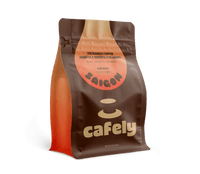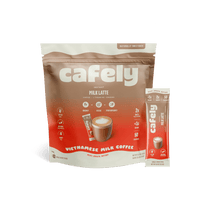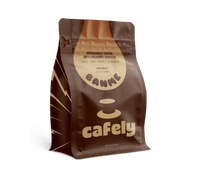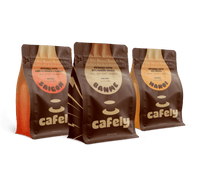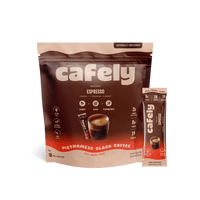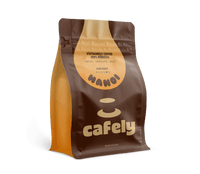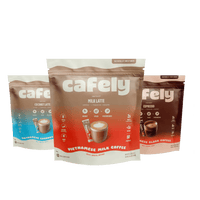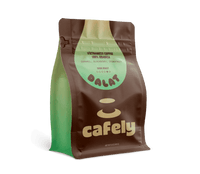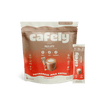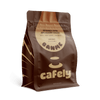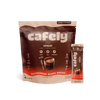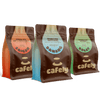Smeg offers a range of beautifully designed coffee machines with a vintage '50s feel. The two most popular coffee makers in the range are the Smeg drip coffee maker and the Smeg manual espresso machine.
Both of these machines are made for domestic use but are capable of producing barista-level coffee. They're easy to use, but a certain level of skill is involved in the brewing process.
In this brew guide, you'll learn how to brew delicious drip coffee for your daily brew and bold, dark espresso for a caffeine-rich treat using the Smeg coffee machines.
Smeg Coffee Maker Brewing Specs
Here are the brewing specs for the Smeg drip coffee maker and espresso machines:
Smeg Drip Coffee Maker:
- Brew Time: 5–10 minutes (depending on volume brewed)
- Coffee/Water Ratio: 1:16
- Grind: Medium-coarse (similar to sea salt)
- Water Temperature: 195–205°F (90–96°C)
- Recommended Coffee: Cafely's DaLat , HaNoi Coffee, Saigon OG
Smeg Espresso Machine:
- Brew Time: 25–30 minutes
- Coffee/Water Ratio: 1:2
- Grind: Fine (similar to powdered sugar)
- Water Temperature: 200°F (93°C)
- Recommended Coffee: DaLat Coffee
What You Need to Make Coffee With the Smeg Drip Coffee Maker

The secret to brewing great drip coffee is in the beans — opt for high-quality whole beans and grind them fresh. You should also measure accurately and use fresh water…
Here's what you need to make coffee with the Smeg drip coffee maker:
Tools Needed
- Smeg Drip Coffee Maker — These coffee machines come in a variety of styles, but they all have the same capacity and carafe size. They're able to brew up to 42 oz (1.25 L) at one time.
- Coffee Grinder — The best drip coffee is made using whole beans. You'll need a burr or blade grinder to produce the medium-coarse grind size required for drip coffee.
- Coffee Measure — Use a coffee measure or weighing scale to accurately measure the coffee. This ensures you produce the same result every time.
- Coffee Filters — The Smeg drip coffee makers require standard paper cone filters. Unbleached produces a cleaner, safer carafe of coffee.
- Coffee Mug — Use your favorite coffee mug to serve the coffee in.
Ingredients
- High-Quality Coffee — Opt for a high-quality whole-bean coffee.
- Water — Use cold, filtered water in your Smeg coffee machine. This prevents mineral buildup and produces a cleaner brew.
- Milk (Optional) — Add a dash of milk for a creamy, white drip coffee.
- Sugar (Optional) — Add a teaspoon of sugar or syrup to sweeten your drip coffee.
Coffee Recommendations
You can use any type of coffee in a Smeg drip coffee machine as long as it's high-quality and freshly ground. We recommend grinding the beans yourself for the best brew.
If you don't have a grinder, opt for a high-quality pre-ground coffee with a recent roast date.
- Arabica coffee — If you enjoy a sweet, subtle, smooth drip coffee, opt for a 100% arabica bean such as DaLat.
- Robusta coffee — If you prefer a dark, slightly bitter brew with a potent caffeine hit, opt for a 100% robusta bean such as HaNoi.
- Blend — If you want the best of both beans, choose a well-balanced arabica and robusta blend such as Saigon OG.
Step-by-Step Guide: Smeg Drip Coffee Maker
Brewing coffee with a Smeg drip coffee maker is simple, but there are a few caveats that'll make or break the quality of your cup.
Follow the steps below to make the perfect cup of coffee with the Smeg drip coffee maker:
1. Prepare Your Machine

First, turn on your drip coffee maker and fill the reservoir with cold, fresh, filtered water.
Place a filter inside the basket and the carafe on the drip tray. Take a cup of water and slowly pour it over the filter until it drips into the carafe below. This will remove impurities from the paper filter. Discard the water from the carafe and return it to the drip tray.
Brewing tip — Use hot water to rinse the filter. This will also preheat your carafe.
2. Measure and Grind the Coffee

To produce the best quality drip coffee, use whole-bean coffee and grind it fresh. The grind size should be medium-coarse — a consistency similar to sea salt.
You'll need around one gram of coffee for every 16 mL of water. Use the table below to work out how much coffee you'll need for your desired serving size:
|
Servings of Coffee |
Coffee |
Water |
|
1–2 Servings |
4 tablespoons (28 grams) |
2 cups (470 mL) |
|
3–4 Servings |
8 tablespoons (56 grams) |
4 cups (950 mL) |
|
5–6 Servings (full carafe) |
12 tablespoons (84 grams) |
6 cups (1.4 L) — full reservoir |
3. Brew The Coffee

Add your ground coffee to the filter basket and close the lid. The Smeg drip coffee maker has two strength settings — light and intense. Select your desired brew strength and click the brew button.
Wait for your coffee to brew. You should see the first drips fall into the carafe below within 30 seconds. It can take anywhere from two to 10 minutes for the brewing process to complete, depending on the volume brewed.
4. Customize and Enjoy

Once your coffee has finished brewing, pour a serving into your coffee mug. Sweeten with sugar or syrup and cream with milk or coffee creamer if desired.
The Smeg drip coffee maker has a “keep warm” setting. You can leave any leftover coffee in the carafe on the drip tray to keep warm for up to one hour.
What You Need to Make Coffee With the Smeg Espresso Machine
Like drip coffee, the key to the perfect espresso is in the beans. However, the brewing process and equipment you'll need are slightly more specialized.
Here's what you need to brew coffee with a Smeg espresso machine:
Equipment
- Smeg Espresso Machine — The Smeg espresso machines are available in several different colors, but they all house the same mechanisms.
- Coffee Measure — Use a coffee measure or weighing scale to accurately portion your coffee.
- Tamper — This is used to pack the fine coffee grounds in the portafilter.
- Demitasse Cup — These small cups are used to serve single or double shots of espresso.
Ingredients
- High-Quality Coffee — Opt for a high-quality whole-bean arabica coffee that has been roasted recently.
- Water — Only use cold, filtered water in your espresso machine. This will produce the cleanest brew and prevent mineral buildup in your espresso machine.
Coffee Recommendations
The best coffee for making espresso using the Smeg espresso machine is arabica. We recommend our DaLat coffee for a bold, smooth, naturally sweet shot of coffee.
Opt for a whole-bean coffee and grind it fresh — this will produce the most charismatic shot of espresso.
Although 100% arabica is recommended for espresso, robusta, and arabica blends such as DaNang can also be used. Blends produce a slightly darker shot with a bitter edge and a stronger caffeine hit.
100% robusta coffee tends to be too intense for most people when brewed with an espresso machine. Robusta produces a bitter, dark shot of espresso with around twice the amount of caffeine as arabica. Although Robusta coffee such as HaNoi blends doesn't produce the best shot in terms of raw flavor, it's the perfect bean for strong, sweetened lattes, intense but pleasantly sweet flat whites, and iced coffee.
Step-by-Step Guide: Smeg Espresso Machine
Making espresso can be daunting for beginners. However, if you follow the steps below closely you'll be brewing barista-level espresso in no time.
Here's how to brew espresso with a Smeg espresso machine:
1. Prepare the Espresso Machine
Begin by switching your Smeg espresso machine on. Unlike many other manual espresso makers, Smeg’s ThermoBlock system heats the machine up in just 40 seconds.
Fill the water reservoir with cold, fresh, filtered water. Avoid using water directly from your tap — hard water can cause a buildup of minerals in the machine which can lead to blockages. It can also taint the taste of the espresso.
2. Measure and Grind the Coffee
You’ll need around nine grams of coffee for a single shot and 18 grams for a double shot of espresso.
Add the desired amount of whole-bean coffee to the coffee bean hopper on your machine. You can add more beans than needed — they’ll stay fresh in the bean container for a week or so.
The Smeg espresso machine has a built-in stainless steel burr grinder capable of producing the fine grind required for brewing espresso. Grind the coffee directly into your portafilter and weigh it, or grind it into a coffee measure and place the appropriate amount in the portafilter.
3. Prepare the Portafilter
Use your tamper to press the coffee firmly and evenly into the portafilter. Apply firm, even pressure but don’t press too hard — over-tamping can result in an uneven extraction.
4. Brew the Espresso
Place a demitasse cup under the spout on your Smeg espresso machine.
Lock the portafilter into the group head of the machine. Press the “brew” button for a single or double shot (depending on how much coffee you’ve placed in the portafilter). Time the extraction — aim for a 25 to 30-second pull for espresso or a 15 to 20-second pull for ristretto.
5. Evaluate and Adjust Your Espresso Shot
Your espresso shot should have a dark, rich body that’s not overly bitter. The crema should be caramel-colored with a thick velvety texture.
If your shot tastes too bitter or sour, assess the quality of your beans. If your beans are fresh, try a lighter or firmer tamp when packing the portafilter. Press lighter if you feel the brew is over-extracted and press harder if it’s under-extracted.
6. Enjoy or Add Milk
Enjoy your espresso shot black, or add steamed milk to create a latte, flat white, or cappuccino coffee. You can also dilute the shot with hot water to create an Americano.
The Smeg espresso machine has a built-in milk steamer that can achieve the velvety texture needed for milk-based espresso brews. It can also produce a fine microfoam for a delicate yet bold macchiato.
FAQs: Brewing Coffee With a Smeg Coffee Maker

Want to learn more about brewing coffee with Smeg’s coffee machines?
Read the answers to the frequently asked questions below:
1. Are Smeg Coffee Machines Good?
Smeg's range of coffee machines are beautifully designed, and they're capable of brewing fantastic coffee — regardless of whether that's drip coffee or espresso. However, many people agree that they're overpriced for the quality.
You can find coffee machines with a much higher build quality for a much cheaper price. The only draw for the Smeg coffee machines is their unique, retro look.
2. What Type of Coffee Can You Make With a Smeg Coffee Machine?
The type of coffee you can make with a Smeg coffee machine depends on the model you select. The brand offers a few different types, but the most popular are the drip coffee maker (makes drip coffee) and the espresso machine (makes espresso and milk-based beverages).
3. Can You Make Iced Coffee With a Smeg Coffee Machine?
Yes. You can make a delicious glass of iced coffee with both the drip coffee maker and the espresso machine from Smeg. To make iced coffee using the drip coffee maker, brew a concentrated coffee by increasing the coffee-to-water ratio, cool it, pour over ice, and add milk. To make iced coffee with the espresso machine, brew an espresso shot as usual, cool it, pour over ice, and add milk.
4. Can You Make a Latte With a Smeg Coffee Machine?
You can make a latte with the Smeg espresso machine but not with the drip coffee maker. Smeg's espresso machine has a built-in steaming wand. To make a latte, you must first brew an espresso and then steam a pitcher of milk until it's light and velvety. The milk can then be gently poured over the espresso to create a rich, creamy latte.
5. What’s the Best Coffee for a Smeg Espresso Machine?
The best coffee for a Smeg espresso machine is high-quality, whole-bean arabica. Arabica beans such as DaLat produce a naturally sweet, smooth, bold shot of espresso. You can also use a well-balanced blend such as Saigon OG for a darker, richer, stronger espresso.
6. What’s the Best Coffee for a Smeg Drip Coffee Maker?
The best coffee for a Smeg drip coffee maker should be high-quality, whole-bean coffee that's ground fresh just before brewing. The type of coffee you use depends on the brew you wish to produce. Arabica produces a smooth, subtle drip coffee, robusta produces a dark, bitter, strong drip coffee, and a blend combines the characteristics of both beans.
7. Can You Make Cold Brew With a Smeg Coffee Maker?
No. You can't make a cold brew with a Smeg coffee maker. However, you can make iced coffee with most machines in the Smeg range. You can also make flash brew — an instantly cooled hot brew — with the Smeg drip coffee maker.
8. How Much Caffeine is in Drip Coffee?
The amount of caffeine in a cup of drip coffee varies depending on bean type, coffee-to-water ratio, and grind size. However, the average 8 oz (240 mL) cup contains somewhere between 90 and 160 mg of caffeine.
9. How Much Caffeine in Espresso?
The average single shot of espresso brewed with 100% arabica coffee contains 75 mg of caffeine. A double shot contains around 150 mg. The strength of a shot brewed with 100% robusta or a blend can contain significantly more caffeine — up to 250 mg (double shot).
10. Can You Add Milk to Drip Coffee?
Yes. You can add a splash of milk to drip coffee to make a creamy, white coffee. You can use whole, semi-skimmed, or skimmed dairy milk or a plant-based vegan alternative such as oat milk, soy milk, or coconut milk.
